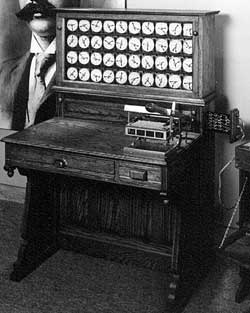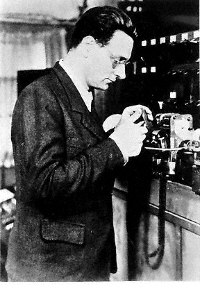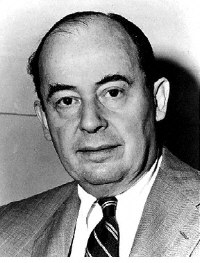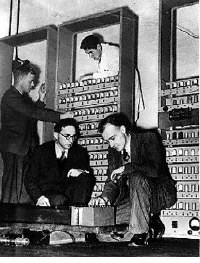|
5,000
years ago - Abacus
The
abacus was used for centuries to carry out calculations on trading
transactions.
1642
- Blaise Pascal
A
Frenchman who invented the numerical wheel calculator to aid
his fathers profession as a French tax collector.
1812
- Charles Babbage
Frustrated
at the many mistakes found whilst examining calculations for
the Royal Astronomical Society, Charles Babbage applied the
ability of machines to the needs of mathematics, thus developing
Charles Babbage's Analytical Engine. Powered by steam and the
size of a locomotive the idea used perforated cards to instrict
the machine.
1889
- Herman Hollerith
Using
the Jacquard loom concept, the American inventor developed a
faster way to compute the USA's census. The machine he developed
used cards to store information that were fed into the machine
and results were compiled mechanically.

Hollerith's
Machine
(Image
courtesy of Computer History Museum)
Each
punch card represented one number and combinations of two punches
represented one letter.
Both
businesses and government used punch cards for data processing
until the 1960's
1938
- Konrad Zuse

Konrad
Zuse
(Image
courtesy of Computer History Museum)
This
German engineer developed and built the worlds first binary
digital computer, the Z1.
World
War II saw many developments in computing as governments looked
for ways to exploit their own strategic importance and put themselves
in an advantageous position against the enemy. Their was a sudden
enhanced development of a number of ordnance devices to counter
an increase in technology on attacking devices.
1941
- Konrad Zuse
In
developing the Z1, the Z3 computer was produced to aid the design
of airplanes and missiles. This was the first fully functional
program controlled electromechanical digital computer. (Computer
History Museum).

Gordon
Riocreux remembering the use of Morse code during World War
II and his experience of a mechanical calculator after the war.
1943
- Colossus
The
British developed the Colossus machine to decode German messages.
This machine was developed in great secrecy by the Post Office
Research Station for the Government Code and Cipher School,
Bletchley Park Buckinghamshire.
During
the war the Germans used two classes of machine, the Enigma
Series and the Gehelmschreiber System, to encode signals prior
to transmission. Both machines scrambled the letters of the
message by a complicated, virtually non-repeating mechanism
of stepping rotors, making the encoded signal extremely difficult
to decipher. Colossus was designed as an all electronic deciphering
computer. (Lavington. S., 1980).
1944
- Howard. H. Aiken
An
American inventor and Harvard engineer who produced the all
electronic calculator. This was half the size of a football
pitch and consisted of 500 miles of wiring!
The
mid 1940's saw concepts in computer design being introduced
and initiated. These remained central to computer engineering
for the next 40 years.
1945
- Jon Von Neumann

Jon
Von Neumann
(Image
courtesy of Computer History Museum)
This
Hungarian born inventor produced EDVAC (Electronic Discrete
Variable Automatic Compiler). The development of this machine
saw computer memory expanding and being able to hold a stored
program as well as data.

John
Silk talking about punch cards
1946
- ENIAC
Electronic
Numerical Integrator and Computer. John Mauchly and J Eckert
demonstrated that high speed digital computing was possible
using the then available vacuum tube technology. This first
large scale general purpose electronic computer laid the foundations
for the modern electronic computing industry. (Goldschmidt and
Akera., 1998).
1946
- Summer School
An inspiring
summer school was held at the University of Pennsylvania computing.
The free public lectures, held in the Moore School of Electrical
Engineering, stimulated and inspired the construction of stored
program computers at universities and research institutions.
This led to the development of other such machines as the EDSAC,
1949, the first practical stored program computer at Cambridge
University.

EDSAC
at Cambridge University
(Image
courtesy of Computer History Museum)

John
Silk explains the role of information retrieval of chemical
literature and punch cards
1948
- The Transistor
The
invention of the transistor replaced the large vacuum tube in
television's, radio's and computers therefore enabling their
decrease in size.

Transistor
(Image
courtesy of Computer History Museum)
|

![]()
